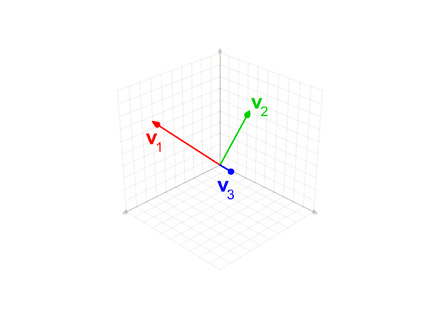Gram–Schmidt process
From Wikipedia, the free encyclopedia
In mathematics, particularly linear algebra and numerical analysis, the Gram–Schmidt process is a method fororthonormalising a set of vectors in an inner product space, most commonly the Euclidean space Rn equipped with the standard inner product. The Gram–Schmidt process takes a finite, linearly independent set S = {v1, ..., vk} for k ≤ n and generates an orthogonal set S′ = {u1, ..., uk} that spans the same k-dimensional subspace of Rn asS.
The method is named after Jørgen Pedersen Gram and Erhard Schmidt but it appeared earlier in the work ofLaplace and Cauchy. In the theory of Lie group decompositions it is generalized by the Iwasawa decomposition.[1]
The application of the Gram–Schmidt process to the column vectors of a full column rank matrix yields the QR decomposition (it is decomposed into an orthogonal and a triangular matrix).
Contents
[hide]The Gram–Schmidt process[edit]
We define the projection operator by
where denotes the inner product of the vectors v and u. This operator projects the vector vorthogonally onto the line spanned by vector u. If u = 0, we define . i.e., the projection map is the zero map, sending every vector to the zero vector.
The Gram–Schmidt process then works as follows:
The sequence u1, ..., uk is the required system of orthogonal vectors, and the normalized vectors e1, ..., ek form an orthonormal set. The calculation of the sequence u1, ...,uk is known as Gram–Schmidt orthogonalization, while the calculation of the sequence e1, ..., ek is known as Gram–Schmidt orthonormalization as the vectors are normalized.
To check that these formulas yield an orthogonal sequence, first compute ‹ u1,u2 › by substituting the above formula for u2: we get zero. Then use this to compute ‹ u1,u3 › again by substituting the formula for u3: we get zero. The general proof proceeds by mathematical induction.
Geometrically, this method proceeds as follows: to compute ui, it projects vi orthogonally onto the subspace U generated by u1, ..., ui−1, which is the same as the subspace generated by v1, ..., vi−1. The vector ui is then defined to be the difference between vi and this projection, guaranteed to be orthogonal to all of the vectors in the subspace U.
The Gram–Schmidt process also applies to a linearly independent countably infinite sequence {vi}i. The result is an orthogonal (or orthonormal) sequence {ui}i such that for natural number n: the algebraic span of v1, ..., vn is the same as that of u1, ..., un.
If the Gram–Schmidt process is applied to a linearly dependent sequence, it outputs the 0 vector on the ith step, assuming that vi is a linear combination of v1, ..., vi−1. If an orthonormal basis is to be produced, then the algorithm should test for zero vectors in the output and discard them because no multiple of a zero vector can have a length of 1. The number of vectors output by the algorithm will then be the dimension of the space spanned by the original inputs.
A variant of the Gram–Schmidt process using transfinite recursion applied to a (possibly uncountably) infinite sequence of vectors yields a set of orthonormal vectors with such that for any , the completion of the span of is the same as that of . In particular, when applied to a (algebraic) basis of a Hilbert space (or, more generally, a basis of any dense subspace), it yields a (functional-analytic) orthonormal basis. Note that in the general case often the strict inequality holds, even if the starting set was linearly independent, and the span of need not be a subspace of the span of (rather, it's a subspace of its completion).
Example[edit]
Consider the following set of vectors in R2 (with the conventional inner product)
Now, perform Gram–Schmidt, to obtain an orthogonal set of vectors:
We check that the vectors u1 and u2 are indeed orthogonal:
noting that if the dot product of two vectors is 0 then they are orthogonal.
For non-zero vectors, we can then normalize the vectors by dividing out their sizes as shown above:



 denotes the
denotes the  . i.e., the projection map
. i.e., the projection map  is the zero map, sending every vector to the zero vector.
is the zero map, sending every vector to the zero vector.
 yields a set of orthonormal vectors
yields a set of orthonormal vectors with
with  such that for any
such that for any  , the
, the  is the same as that of
is the same as that of  . In particular, when applied to a (algebraic) basis of a
. In particular, when applied to a (algebraic) basis of a  holds, even if the starting set was linearly independent, and the span of
holds, even if the starting set was linearly independent, and the span of 





No comments:
Post a Comment